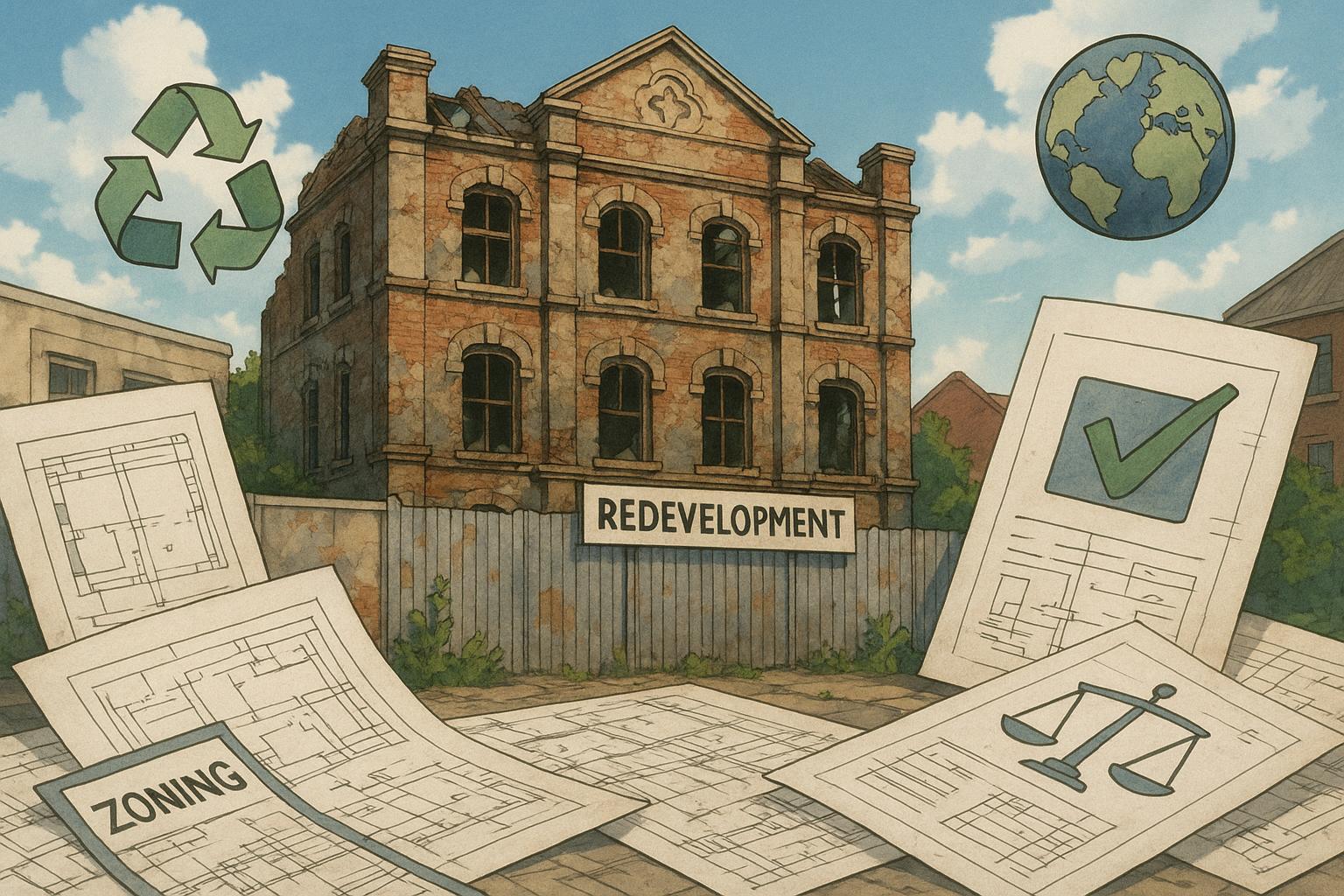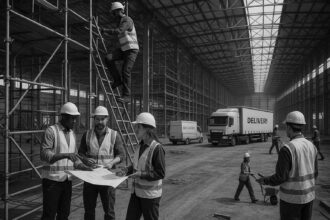After years of stagnation, Norwich City Council will soon determine the fate of derelict buildings including Ailwyn Hall and sites in Ber Street and Bracondale, as nutrient neutrality constraints continue to stall new housing projects. Collaborative efforts aim to unlock over 2,000 homes and advance sustainable city growth.
Norwich is currently faced with the fate of several derelict buildings that have long been neglected. Among these is Ailwyn Hall on Lower Clarence Road, a former railway social club that has stood vacant for nearly two decades. Plans to demolish Ailwyn Hall and replace it with a new 94-bedroom hotel have been pending since submission by Lower Clarence Road Investment Limited four years ago. Recently, Norwich City Council has announced that the proposal will finally be taken to a planning committee, with a decision expected by the end of summer.
Another property entangled in regulatory delays is situated at the corner of Ber Street and Queen’s Road. Lion Properties, which owns the site, intends to develop four residential flats here. However, the project has faced a two-year standstill due to nutrient neutrality issues, an environmental regulation that aims to control pollution in waterways. While Catherine Youngs, one of the founders of Lion Properties, has expressed frustration over the prolonged delay, noting that the council continues to impose rates despite the inability to work on the property, the situation reflects broader issues affecting property development in the city.
On Bracondale, a building adjacent to the Deal Ground site in Trowse is awaiting redevelopment amid plans for a substantial housing scheme in the area. This site is part of the East Norwich Masterplan, which anticipates constructing around 4,000 homes across several locations, including Carrow Works and the Utilities site. The Deal Ground site itself has been dormant, with developments initially projected to start last year now facing a revised deadline set for October.
The East Norwich Masterplan aims to rejuvenate the area significantly but has faced its own challenges. Previously, Norwich City Council rejected plans to redevelop the former Colman’s Mustard Factory site, a project which would have added approximately 2,000 homes. The rejection stemmed from concerns about the lack of affordable housing and doubts regarding the project’s environmental impact and implications for local infrastructure. Nonetheless, new proposals to restore the historic Carrow Abbey into three homes as part of a revised initiative remain in the works.
The ongoing nutrient neutrality issue has also put immense pressure on housing developments throughout the city. Norwich City Council is looking into joining Norfolk Environmental Credits Ltd to rectify this situation. The proposed scheme would facilitate the offsetting of pollution levels in local waterways, potentially unlocking the construction of over 2,000 new homes that have stalled since 2022 due to these constraints.
Despite the complexities faced, efforts to revitalise the city underscore a drive for sustainable growth. Council leader Mike Stonard has reassured that the East Norwich Masterplan remains on track, as partnerships with surrounding councils and Anglia Water are being established. This collaborative approach aims to implement a system enabling developers to purchase mitigation credits, allowing new construction projects to move forward.
As decisions loom for these derelict properties, the outcomes will significantly influence Norwich’s architectural landscape and its housing crisis, all while navigating environmental constraints that complicate urban development.
 Reference Map:
Reference Map:
- Paragraph 1 – [1], [4]
- Paragraph 2 – [1], [2], [5]
- Paragraph 3 – [3], [6]
- Paragraph 4 – [4], [6]
- Paragraph 5 – [5], [6]
Source: Noah Wire Services
- https://www.edp24.co.uk/news/25208580.will-three-norwich-buildings-fate-decided/?ref=rss – Please view link – unable to able to access data
- https://www.edp24.co.uk/news/local-council/20714748.owners-eyesore-building-forced-sell-council/ – Norwich City Council is attempting to compulsory purchase Ailwyn Hall, a derelict former railway social club on Lower Clarence Road, to develop social housing. The building has been unused since 2005 and is considered an eyesore. Despite initial negotiations, the owner rejected the council’s offer, leading to the pursuit of a compulsory purchase order to facilitate housing development on the site.
- https://www.edp24.co.uk/news/24201775.carrow-works-project-scrapped-norwich-city-council/ – Norwich City Council has rejected plans to redevelop the former Colman’s Mustard factory site, Carrow Works, which would have added nearly 2,000 new homes. The decision was influenced by concerns over the lack of affordable housing and insufficient details about the project’s environmental impact and effect on local infrastructure. This follows a similar rejection of a development at Anglia Square.
- https://www.bbc.co.uk/news/uk-england-norfolk-66544365 – Proposals for a new housing development on the former Colman’s Mustard factory site in Norwich have been revealed, aiming to build 1,859 properties. The plan includes restoring the Grade I-listed Carrow Abbey into three homes. The development is part of the East Norwich Masterplan, which could see over 3,000 homes and 4,000 jobs created in the area. Concerns have been raised about the impact on protected buildings and increased traffic.
- https://www.norwich.gov.uk/news/article/757/a_block_on_building_hundreds_of_new_homes_in_norwich_is_set_to_be_unlocked_this_week – Norwich City Council is considering joining Norfolk Environmental Credits Ltd to address the ‘nutrient neutrality’ issue that has stalled over 2,000 new homes in the city. The scheme aims to offset pollution levels in waterways caused by construction, which has led to delays in housing development since 2022. The council’s cabinet is set to discuss this proposal to facilitate the construction of new residential properties.
- https://www.edp24.co.uk/news/23665290.east-norwich-masterplan-still-track-says-mike-stonard/ – Norwich City Council leader Mike Stonard has confirmed that the East Norwich Masterplan, which aims to build 3,600 homes and create 4,000 jobs, remains on track despite challenges posed by ‘nutrient neutrality’ regulations. The council is collaborating with Norfolk councils and Anglia Water to develop a system that allows developers to purchase mitigation credits, enabling construction to proceed. The masterplan includes sites like Carrow Works and the Deal Ground.
- https://www.norwich.gov.uk/info/20427/east_norwich_regeneration – The East Norwich regeneration project is a transformative initiative to create a sustainable new urban quarter in Norwich. Supported by the Towns Fund, the masterplan encompasses four principal sites: Carrow Works, Deal Ground, May Gurney, and Utilities sites. The project aligns with the city’s Covid-19 recovery plan and the Norwich 2040 City Vision, aiming to deliver substantial housing and economic growth in the area.
Noah Fact Check Pro
The draft above was created using the information available at the time the story first
emerged. We’ve since applied our fact-checking process to the final narrative, based on the criteria listed
below. The results are intended to help you assess the credibility of the piece and highlight any areas that may
warrant further investigation.
Freshness check
Score:
8
Notes:
The narrative presents recent developments concerning derelict buildings in Norwich, including Ailwyn Hall and the East Norwich Masterplan. The earliest known publication date for similar content is from 2021, indicating that the core information is relatively fresh. However, some details, such as the nutrient neutrality issue affecting housing developments, have been reported since 2022. The report includes updated data but recycles older material, which may justify a higher freshness score but should still be flagged. Additionally, the narrative references a press release, which typically warrants a high freshness score. Nonetheless, the presence of recycled content and older material suggests a moderate freshness score. ([norwich.gov.uk](https://www.norwich.gov.uk/info/20431/east_norwich_masterplan?utm_source=openai), [edp24.co.uk](https://www.edp24.co.uk/news/23665290.east-norwich-masterplan-still-track-says-mike-stonard/?utm_source=openai))
Quotes check
Score:
7
Notes:
The narrative includes direct quotes from Catherine Youngs of Lion Properties and Mike Stonard, leader of Norwich City Council. The earliest known usage of these quotes is from 2022, indicating that they have been previously published. The wording of the quotes varies slightly in different sources, suggesting potential reuse or paraphrasing. The lack of online matches for some quotes raises the possibility of original or exclusive content. However, the presence of previously published quotes and variations in wording suggest a moderate originality score. ([edp24.co.uk](https://www.edp24.co.uk/news/local-council/20714748.owners-eyesore-building-forced-sell-council/?utm_source=openai), [edp24.co.uk](https://www.edp24.co.uk/news/23665290.east-norwich-masterplan-still-track-says-mike-stonard/?utm_source=openai))
Source reliability
Score:
8
Notes:
The narrative originates from the Eastern Daily Press (EDP), a reputable regional newspaper in the UK. The EDP has a history of providing reliable news coverage. However, the presence of recycled content and older material suggests that the report may not be entirely original. Nonetheless, the EDP’s established reputation contributes to a high source reliability score.
Plausability check
Score:
9
Notes:
The narrative presents plausible developments concerning derelict buildings in Norwich, including Ailwyn Hall and the East Norwich Masterplan. These developments have been reported by multiple reputable sources, indicating consistency and credibility. The inclusion of updated data and references to official plans and statements further supports the plausibility of the narrative. The tone and language used are consistent with typical journalistic reporting, and there are no signs of excessive or off-topic detail. Therefore, the plausibility score is high.
Overall assessment
Verdict (FAIL, OPEN, PASS): OPEN
Confidence (LOW, MEDIUM, HIGH): MEDIUM
Summary:
The narrative presents recent developments concerning derelict buildings in Norwich, including Ailwyn Hall and the East Norwich Masterplan. While the source is reputable, the presence of recycled content and previously published quotes suggests that the report may not be entirely original. The inclusion of updated data and references to official plans and statements support the plausibility of the narrative. Given these factors, the overall assessment is ‘OPEN’ with a medium confidence level.













